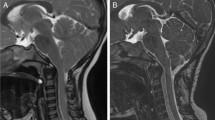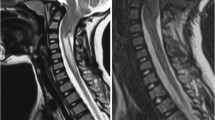Abstract
Purpose
The optimal treatment for Chiari I malformation in children is still under debate. The aim of this study was to evaluate the surgical outcome of the pediatric Chiari I malformation, focusing on clinico-radiological factors and technical aspects.
Methods
Fifty-six patients with Chiari I malformation who received surgery at Seoul National University Children’s Hospital were included. The mean age was 7.9 years. The patients were divided into three groups: group I (n = 8) with hydrocephalus, group II (n = 11) without syrinx, and group III (n = 37) with syrinx. Group I received shunting operation initially, and others received foramen magnum decompression (FMD). Group III was further subdivided: group IIIa (n = 9), minimal intradural manipulation, and group IIIb (n = 27), active intradural manipulation. The outcomes were compared between the groups. The mean follow-up period was 75.9 months.
Results
In group I, symptoms were resolved or had improved in most patients, with only one patient received additional FMD. Symptoms resolved or improved in 10 (91 %) and 25 cases (84 %) in groups II and III, respectively. Syrinx was markedly decreased in 31 cases (86 %) in group III. FMD was less effective for scoliosis (improved or stabilized in 57 %). The persistence of syrinx was related with an aggravation of scoliosis. The outcomes between group IIIa and IIIb showed no significant difference.
Conclusions
In most pediatric Chiari I patients with hydrocephalus, a shunting operation was sufficient. FMD showed high efficacy in treating patients without hydrocephalus. The extent of the intradural procedure did not have a significant effect on the clinical outcome.



Similar content being viewed by others
Reference
Chiari H (1987) Concerning alterations in the cerebellum resulting from cerebral hydrocephalus. Pediatr Neurosci 13:3–8
Caldarelli M, Novegno F, Vassimi L, Romani R, Tamburrini G, Di Rocco C (2007) The role of limited posterior fossa craniectomy in the surgical treatment of Chiari malformation type I: experience with a pediatric series. J Neurosurg 106:187–195
Dyste GN, Menezes AH, VanGilder JC (1989) Symptomatic Chiari malformations. An analysis of presentation, management, and long-term outcome. J Neurosurg 71:159–168
Park JK, Gleason PL, Madsen JR, Goumnerova LC, Scott RM (1997) Presentation and management of Chiari I malformation in children. Pediatr Neurosurg 26:190–196
McGirt MJ, Attenello FJ, Atiba A, Garces-Ambrossi G, Datoo G, Weingart JD, Carson B, Jallo GI (2008) Symptom recurrence after suboccipital decompression for pediatric Chiari I malformation: analysis of 256 consecutive cases. Childs Nerv Syst 24:1333–1339
Tubbs RS, Beckman J, Naftel RP, Chern JJ, Wellons JC 3rd, Rozzelle CJ, Blount JP, Oakes WJ (2011) Institutional experience with 500 cases of surgically treated pediatric Chiari malformation type I. J Neurosurg Pediatr 7:248–256
Munshi I, Frim D, Stine-Reyes R, Weir BK, Hekmatpanah J, Brown F (2000) Effects of posterior fossa decompression with and without duraplasty on Chiari malformation-associated hydromyelia. Neurosurgery 46:1384–1389, discussion 1389–1390
Genitori L, Peretta P, Nurisso C, Macinante L, Mussa F (2000) Chiari type I anomalies in children and adolescents: minimally invasive management in a series of 53 cases. Childs Nerv Syst 16:707–718
Aboulezz AO, Sartor K, Geyer CA, Gado MH (1985) Position of cerebellar tonsils in the normal population and in patients with Chiari malformation: a quantitative approach with MR imaging. J Comput Assist Tomogr 9:1033–1036
Tubbs RS, Elton S, Grabb P, Dockery SE, Bartolucci AA, Oakes WJ (2001) Analysis of the posterior fossa in children with the Chiari 0 malformation. Neurosurgery 48:1050–1054, discussion 1054–1055
Tubbs RS, Iskandar BJ, Bartolucci AA, Oakes WJ (2004) A critical analysis of the Chiari 1.5 malformation. J Neurosurg 101:179–183
Kim IK, Wang KC, Kim IO, Cho BK (2010) Chiari 1.5 malformation: an advanced form of Chiari I malformation. J Korean Neurosurg Soc 48:375–379
Eule JM, Erickson MA, O’Brien MF, Handler M (2002) Chiari I malformation associated with syringomyelia and scoliosis: a twenty-year review of surgical and nonsurgical treatment in a pediatric population. Spine (Phila Pa 1976) 27:1451–1455
McGirt MJ, Atiba A, Attenello FJ, Wasserman BA, Datoo G, Gathinji M, Carson B, Weingart JD, Jallo GI (2008) Correlation of hindbrain CSF flow and outcome after surgical decompression for Chiari I malformation. Childs Nerv Syst 24:833–840
El-Ghandour NM (2012) Long-term outcome of surgical management of adult Chiari I malformation. Neurosurg Rev 35:537-546
Attenello FJ, McGirt MJ, Gathinji M, Datoo G, Atiba A, Weingart J, Carson B, Jallo GI (2008) Outcome of Chiari-associated syringomyelia after hindbrain decompression in children: analysis of 49 consecutive cases. Neurosurgery 62:1307–1313, discussion 1313
Flynn JM, Sodha S, Lou JE, Adams SB Jr, Whitfield B, Ecker ML, Sutton L, Dormans JP, Drummond DS (2004) Predictors of progression of scoliosis after decompression of an Arnold Chiari I malformation. Spine (Phila Pa 1976) 29:286–292
Attenello FJ, McGirt MJ, Atiba A, Gathinji M, Datoo G, Weingart J, Carson B, Jallo GI (2008) Suboccipital decompression for Chiari malformation-associated scoliosis: risk factors and time course of deformity progression. J Neurosurg Pediatr 1:456–460
Tubbs RS, Lyerly MJ, Loukas M, Shoja MM, Oakes WJ (2007) The pediatric Chiari I malformation: a review. Childs Nerv Syst 23:1239–1250
Batzdorf U, McArthur DL, Bentson JR (2013) Surgical treatment of Chiari malformation with and without syringomyelia: experience with 177 adult patients. J Neurosurg 118:232–242
Loukas M, Shayota BJ, Oelhafen K, Miller JH, Chern JJ, Tubbs RS, Oakes WJ (2011) Associated disorders of Chiari type I malformations: a review. Neurosurg Focus 31:E3
Amer TA, el-Shmam OM (1997) Chiari malformation type I: a new MRI classification. Magn Reson Imaging 15:397–403
Caldarelli M, Di Rocco C (2004) Diagnosis of Chiari I malformation and related syringomyelia: radiological and neurophysiological studies. Childs Nerv Syst 20:332–335
Meadows J, Kraut M, Guarnieri M, Haroun RI, Carson BS (2000) Asymptomatic Chiari type I malformations identified on magnetic resonance imaging. J Neurosurg 92:920–926
Novegno F, Caldarelli M, Massa A, Chieffo D, Massimi L, Pettorini B, Tamburrini G, Di Rocco C (2008) The natural history of the Chiari type I anomaly. J Neurosurg Pediatr 2:179–187
Strahle J, Muraszko KM, Kapurch J, Bapuraj JR, Garton HJ, Maher CO (2011) Natural history of Chiari malformation type I following decision for conservative treatment. J Neurosurg Pediatr 8:214–221
Chern JJ, Gordon AJ, Mortazavi MM, Tubbs RS, Oakes WJ (2011) Pediatric Chiari malformation type 0: a 12-year institutional experience. J Neurosurg Pediatr 8:1–5
McGirt MJ, Nimjee SM, Fuchs HE, George TM (2006) Relationship of cine phase-contrast magnetic resonance imaging with outcome after decompression for Chiari I malformations. Neurosurgery 59:140–146, discussion 140–146
Galarza M, Sood S, Ham S (2007) Relevance of surgical strategies for the management of pediatric Chiari type I malformation. Childs Nerv Syst 23:691–696
Albert GW, Menezes AH, Hansen DR, Greenlee JD, Weinstein SL (2010) Chiari malformation type I in children younger than age 6 years: presentation and surgical outcome. J Neurosurg Pediatr 5:554–561
Arai S, Ohtsuka Y, Moriya H, Kitahara H, Minami S (1993) Scoliosis associated with syringomyelia. Spine (Phila Pa 1976) 18:1591–1592
Huebert HT, MacKinnon WB (1969) Syringomyelia and scoliosis. J Bone Joint Surg Br 51:338–343
Isu T, Chono Y, Iwasaki Y, Koyanagi I, Akino M, Abe H, Abumi K, Kaneda K (1992) Scoliosis associated with syringomyelia presenting in children. Childs Nerv Syst 8:97–100
Musson RE, Warren DJ, Bickle I, Connolly DJ, Griffiths PD (2010) Imaging in childhood scoliosis: a pictorial review. Postgrad Med J 86:419–427
Nakahara D, Yonezawa I, Kobanawa K, Sakoda J, Nojiri H, Kamano S, Okuda T, Kurosawa H (2011) Magnetic resonance imaging evaluation of patients with idiopathic scoliosis: a prospective study of four hundred seventy-two outpatients. Spine (Phila Pa 1976) 36:E482–485
Inoue M, Minami S, Nakata Y, Otsuka Y, Takaso M, Kitahara H, Tokunaga M, Isobe K, Moriya H (2005) Preoperative MRI analysis of patients with idiopathic scoliosis: a prospective study. Spine (Phila Pa 1976) 30:108–114
Yamada K, Yamamoto H, Nakagawa Y, Tezuka A, Tamura T, Kawata S (1984) Etiology of idiopathic scoliosis. Clin Orthop Relat Res: 50–57
Cheng JC, Guo X, Sher AH, Chan YL, Metreweli C (1999) Correlation between curve severity, somatosensory evoked potentials, and magnetic resonance imaging in adolescent idiopathic scoliosis. Spine (Phila Pa 1976) 24:1679–1684
Muhonen MG, Menezes AH, Sawin PD, Weinstein SL (1992) Scoliosis in pediatric Chiari malformations without myelodysplasia. J Neurosurg 77:69–77
Wyatt MP, Barrack RL, Mubarak SJ, Whitecloud TS, Burke SW (1986) Vibratory response in idiopathic scoliosis. J Bone Joint Surg Br 68:714–718
Brockmeyer DL (2011) Editorial. Chiari malformation type I and scoliosis: the complexity of curves. J Neurosurg Pediatr 7:22–23, discussion 23–24
Tubbs RS, Pugh AP, Oakes WJ (2011) Chiari malformations. Elsevier Saunders, Philadelphia
Nagib MG (1994) An approach to symptomatic children (ages 4–14 years) with Chiari type I malformation. Pediatr Neurosurg 21:31–35
Rocque BG, George TM, Kestle J, Iskandar BJ (2011) Treatment practices for Chiari malformation type I with syringomyelia: results of a survey of the American Society of Pediatric Neurosurgeons. J Neurosurg Pediatr 8:430–437
Heiss JD, Suffredini G, Smith R, DeVroom HL, Patronas NJ, Butman JA, Thomas F, Oldfield EH (2010) Pathophysiology of persistent syringomyelia after decompressive craniocervical surgery. Clinical article. J Neurosurg Spine 13:729–742
Acknowledgments
This study was supported by a grant obtained from the Korea Healthcare Technology R&D Project, Ministry for Health, Welfare & Family Affairs, Republic of Korea (A120099).
Author information
Authors and Affiliations
Corresponding author
Rights and permissions
About this article
Cite this article
Lee, S., Wang, KC., Cheon, JE. et al. Surgical outcome of Chiari I malformation in children: clinico-radiological factors and technical aspects. Childs Nerv Syst 30, 613–623 (2014). https://doi.org/10.1007/s00381-013-2263-9
Received:
Accepted:
Published:
Issue Date:
DOI: https://doi.org/10.1007/s00381-013-2263-9




